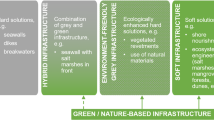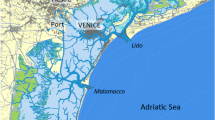Abstract
In this paper, the application of a hybrid coastal morphodynamic model to forecast inter-annual beach change is discussed through the prediction of beach change in a high energy sandy beach over a period of 5 years. The modelling approach combines a ‘reduced-physics’ formulation with a data-driven approach through an inverse technique to form the hybrid coastal morphodynamic model. The beach considered for the demonstration of the model is the Narrabeen Beach, which is a dynamic sand beach located in New South Wales, Australia. Despite its simplicity, we find that the model is able to capture beach change at Narrabeen Beach at inter-annual timescales with root mean square error between measured and computed beach profiles less than 0.4 m on average. Even though the model is used to forecast inter-annual beach change in this study, its ability to predict beach change is not limited to that timescale but depends on the frequency of historic beach profile measurements available to determine key unknown parameters of the model. Also, the length of profile forecasts largely depends on the length of available historic measurements where longer data sets allow longer predictions within a range of beach behaviour contained in the observations. The ability of the model to reliably forecast coastal change at inter-annual and potentially at other timescales, and its high efficiency make it possible to be used in providing multiple simulations required for probabilistic coastal change forecasts which will be very useful for coastal management purposes.











Similar content being viewed by others
References
Burg, JP (1975) Maximum entrophy spectral analysis. PhD dissertation, Department of Geophysics, Stanford University, USA
Burgh J, Manning AJ (2007) An assessment of a new settling velocity parameterisation for cohesive sediment transport modelling. Cont Shelf Res 37(13):1835e1855
Callaghan D, Nielsen P, Short A, Ranasinghe R (2008) Statistical simulation of wave climate and extreme beach erosion. Coast Eng 55:375–390
Coulthard TJ, Macklin MG, Kirkby MJ (2002) A cellular model of Holocene upland river basin and alluvial fan evolution. Earth Surf Proc Landf 27:269–288
Cowell PJ, Roy PS, Jones RA (1992) Shoreface translation model: computer simulation of coastal sand body response to sea level rise. Mathmat Compt Simulation 33:603–608
Cowell PJ, Roy PS, Jones RA (1994) Simulation of LSCB using a morphological behaviour model. Mar Geol 126:45–61
Dabees M. and Kamphuis W. (1998) Oneline, a numerical model for shoreline change. Proc. International Conference in Coastal Engineering, Copenhagen, Denmark, pp. 2668–2681
Davidson MA, Splinter KD, Turner IL (2012) A simple equilibrium model for predicting shoreline change. Coast Eng 73:191–202
Davidson MA & Turner IL 2009. A behavioral template beach profile model for predicting seasonal to interannual shoreline evolution, Journal of Geophys. Res. Earth Surface, 114 DOI: 10.1029/2007JF000888
Dean RG (1991) Equilibrium beach profiles: characteristics and applications. J Coast Res 7(1):53–84
Flather, R.A. (1984) A numerical model investigation of a storm surge of 31 January and 1 February 1953 in the North Sea. The Quarterly Journal of the Royal Meteorological Society, 591e612.
Hanson H, Arrninkhof S, Capobianco M, Mimenez JA, Karson M, Nicholls RJ, Plant NG, Southgate HN, Steetzel HJ, Stive MJF, De Vriend HJ (2003) Modelling of coastal evolution on early and decadal time scales. J Coast Res 19(4):790–811
Hanson H, Kraus NC (1989) "GENESIS: Generalised model for simulating shoreline change, Report 1:Technical reference," Tech. Rep. CERC-89-19, US Army Engineer Waterways Experimental Station, Vicksburg, MS
Harley MD, Turner IL, Short AD, Ranasinghe R (2011) A re-evaluation of coastal embayment rotation: the dominance of cross-shore versus longshore sediment transport process, Colloroy-Narrabeen Beach, Southeast Australia. J Geophys Res 116:F04033
Harley MD, Turner IL, Short AD, Ranasinghe R (2010) Interannual variability and controls of the Sydney wave climate. Int J Climatol 30:1322–1335
Huthnance JM (1982) On the formation of sand banks of finite extent. Estuar Coast Shelf Sci 15:277e299
Karunarathna H, Reeve DE, Spivack M (2008) Long term morphodynamic evolution of estuaries: an inverse problem. Estuar Coast Shelf Sci 77:386–395
Karunarathna H, Reeve DE, Spivack M (2009) Beach profile evolution as an inverse problem. Cont Shelf Res 29:2234–2239
Karunarathna H, Horrillo-Caraballo JM, Spivack M, Reeve DE (2011) Analysis of key parameters in a diffusion type beach profile evolution model. Cont Shelf Res 31:98–107
Karunarathna H., Horrillo-Caraballo J.M., Reeve D.E. (2012a) Prediction of cross-shore beach profile evolution using a diffusion type model. Cont Shelf Res 48:157–166
Karunarathna H, Horrillo-Caraballo JM, Ranasinghe R, Short AD, Reeve DE (2012b) An analysis of the cross-shore beach morphodynamics of a sandy and a composite gravel beach. Mar Geol 299–302:33–42. doi:10.1016/j.margeo.2011.12.011
Kroon A, Larson M, Moller I, Yokoki H, Rozynski G, Cox J, Larroude P, (2008) Statistical analysis of coastal morphological data sets over seasonal to decadal time scales. Coastal Engineering 55:581–600
Larson M, Capobianco M, Jansen H, Rozynski G, Southgate H, Stive M, Wijnberg K, Hulscher S (2003) Analysis and modeling of field data on coastal morphology over early and decadal time scales. Part I: background and linear techniques. J Coast Res 19:760–775
Lesser G, Roelvink JA, Van Kester JATM, Stelling GS (2004) Development and validation of a three dimensional morphological model. Coast Eng 51:883–915
Masselink G, Pattiarachchi CB (1998) The effect of sea breeze on beach morphology, surf zone hydrodynamics and sediment re-suspension. Mar Geol 146:115e135
Murray AB, Paola C (1994) A cellular model of braided rivers. Nature 371:54–57
Niedoroda AW, Reed CW, Swift CW, Arato H, Hoyanagi K (1995) Modelling shore-normal large-scale coastal evolution. Mar Geol 126:181–199
Pelnard Considéré R (1956) Essi de theorie de l’evolution des formes de ravage en plages de sables et de galets, Societe Hydrotechnique de France, IV’eme Journee de L’Hydraulique. Question III Rapport 1:74–1, 10
Percival DB, Walden AT (1993) Spectral analysis for physical applications: multitaper and conventional univariate techniques. CUP, Cambridge, UK
Pruszak Z (1993) The analysis of beach profile changes using Dean’s method and empirical orthogonal functions. Coast Eng 19:245–261
Ranasinghe R, McLoughlin R, Short A, Symonds G (2004) The Southern Oscillation Index, wave climate and beach rotation. Mar Geol 204:273–287
Reeve DE, Fleming CA (1997) A statistical-dynamical method for predicting long term coastal evolution. Coast Eng 30:259–280
Reeve DE, Horrillo-Caraballo JM, Magar V (2008) Statistical analysis and forecasts of long-term sand bank evolution at Great Yarmouth, UK. Estuar Coast Shelf Sci 79:387-399
Reeve DE, Spivack M (2000) Inverse methods in coastal morphology. Proc. Int. Conf. Coastal Eng, Sydney, Australia, pp 3409–3418
Reeve DE, Li B, Thurston N (2001) Eigenfunction analysis of decadal fluctuations in sandbank morphology at Great Yarmouth. J Coast Res 17(2):371–382
Roelvink D, Jeuken MCJL, vanHolland G, Aarninkhof SGL, Stam JMT (2001) Long term process based modelling of complex areas. Coastal Dynamics, Lund, Sweden, pp 383–392
Short AD, Wright LD (1981) Beach systems of the Sydney region. Aust Geogr 15:8–16
Short AD, Trembanis AC (2004) Decadal scale patterns in beach oscillation and rotation Narrabeen Beach, Australia-Time series, PCA and wavelet analysis. J Coast Res 20(2):523–532
Stive MJF, De Vriend HJ (1995) Modelling shore-face profile evolution. Mar Geol 126:235–248
Van Rijn LC, Walstra DJR, Grasmeijer J, Sutherland J, Pan S, Sierra JP (2003) The predictability of cross-shore bed evolution of sandy beaches at the time scale of storms and seasons using process based profile models. Coast Eng 47:295–327
Wijnberg KM, Terwindt JHJ (1995) Extracting decadal morphological behaviour from high-resolution, long-term bathymetric surveys along the Holland coast using eigenfunction analysis. Mar Geol 126:301–330
Winant CD, Inman D, Nordstrom CE (1975) Description of seasonal beach changes using empirical eigenfunctions. J Geophys Res 80(15):1979–1986
Wright LD, Short AD (1984) Morphodynamic variability of surf zones and beaches: a synthesis, Mar Geol 56:93–118
Acknowledgements
HK and RR are thankful to Prof. Andrew Short, University of Sydney, for providing beach profile measurements Narrabeen Beach. HK and DER acknowledge the support of iCOASST (NE/J005428/1) project funded by the Natural Environmental Research Council (NERC), UK.
Author information
Authors and Affiliations
Corresponding author
Additional information
Responsible Editor: Han Winterwerp
Rights and permissions
About this article
Cite this article
Karunarathna, H., Ranasinghe, R. & Reeve, D.E. A hybrid beach morphology model applied to a high energy sandy beach. Ocean Dynamics 65, 1411–1422 (2015). https://doi.org/10.1007/s10236-015-0884-0
Received:
Accepted:
Published:
Issue Date:
DOI: https://doi.org/10.1007/s10236-015-0884-0




